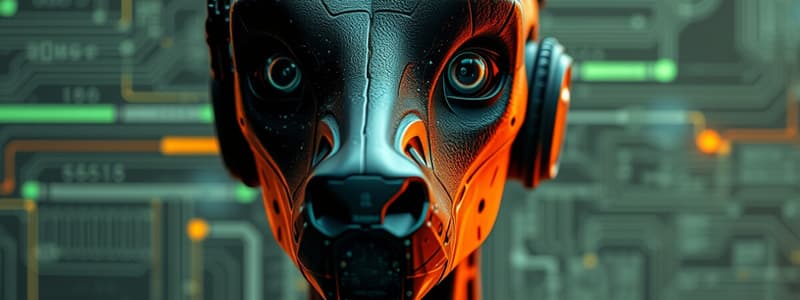Podcast
Questions and Answers
What is computer vision?
What is computer vision?
A subset of artificial intelligence that involves extracting information from images, text, and videos in a manner similar to human vision.
Which of the following tasks can computer vision systems excel in? (Select all that apply)
Which of the following tasks can computer vision systems excel in? (Select all that apply)
- Cooking food
- Product inspection (correct)
- Infrastructure monitoring (correct)
- Writing text
Deep learning models in computer vision perform at a level exceeding human capabilities.
Deep learning models in computer vision perform at a level exceeding human capabilities.
True (A)
What are the three basic steps in how computer vision works?
What are the three basic steps in how computer vision works?
Computer Vision primarily relies on ______ techniques to understand visual data.
Computer Vision primarily relies on ______ techniques to understand visual data.
What is a convolutional neural network (CNN)?
What is a convolutional neural network (CNN)?
Match the image annotation types with their descriptions:
Match the image annotation types with their descriptions:
Which of the following is an application of computer vision in healthcare?
Which of the following is an application of computer vision in healthcare?
Study Notes
Computer Vision Overview
- A branch of artificial intelligence focused on enabling machines to interpret and understand visual information similar to human vision.
- Techniques are developed to extract meaningful data from images, videos, and text.
Value of Computer Vision
- Excels in tasks like product inspection and infrastructure monitoring, detecting defects quickly and accurately.
- Often surpasses human abilities in speed, objectivity, and accuracy, especially in image recognition tasks such as facial recognition and object detection.
How Computer Vision Works
- Image Acquisition: Collects images in real-time through various methods like videos, photos, or 3D technology.
- Processing and Annotation: Involves training models with thousands of labeled images, cleaning data, and performing annotations based on the use case.
- Understanding: The final stage where the system identifies or classifies objects within the images.
Technology Behind Computer Vision
- Primarily utilizes deep learning, a subset of machine learning.
- Convolutional Neural Networks (CNNs) are critical in modern CV programs, allowing algorithms to decipher images by analyzing labeled pixel data.
Types of Image Annotation
- 2D Bounding Boxes: Basic rectangular markers used to identify objects.
- 3D Bounding Boxes: Three-dimensional markers for a more accurate representation of space.
- Polygons: Complex shapes used to outline non-rectangular objects.
- Landmarking: Identifying specific points of interest within images.
- Lines and Splines (Polyline): Used to represent outlines or curves.
- Semantic Segmentation: Classifying each pixel to understand image context and components distinctly.
Applications and Use Cases of Computer Vision
- Manufacturing: Enhances quality control through automated inspections.
- Healthcare: Important for medical imaging and diagnostics.
- Security: Involves theft detection, intrusion detection, and facial recognition applications.
- Agriculture: Optimizes crop monitoring and management tasks.
- Smart Cities: Implements vehicle counting and weapon detection systems.
- Retail: Improves inventory management and detection processes.
- Insurance: Assists in safety compliance inspections.
- Logistics: Utilized in cargo logistics to streamline operations.
- Pharmaceuticals: Detects defects in capsules and ensures product quality.
Conclusion
- Emphasizes the transformative potential of computer vision across various sectors, enhancing efficiency and accuracy in numerous applications.
Questions?
- Open for inquiries and further discussion on the topic.
Studying That Suits You
Use AI to generate personalized quizzes and flashcards to suit your learning preferences.
Related Documents
Description
This quiz explores core concepts of computer vision as part of an AI Hackathon training module. Participants will learn about algorithms and techniques used to extract meaningful information from visual inputs, akin to human sight. It's crucial for anyone interested in understanding the transformative capabilities of AI in analyzing images and videos.




